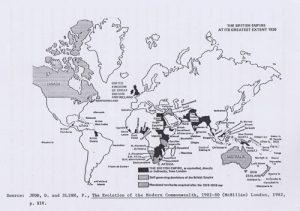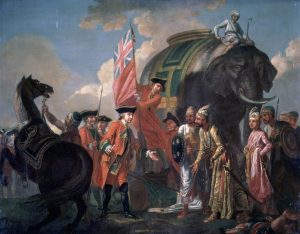American Anti-Colonialism, and the Liquidation of the British Empire.
The co-operation between Britain and the empire reached its highest and closest level during the First World War. This fact was accepted by the Dominions in different degrees. Joseph Cook, the Prime Minister of Australia, said, ” ‘Australia is part of the Empire. When the Empire is at war, so is Australia.’ “31 New Zealand acted similarly, and Canada too became involved, although there were some reservations as the Liberal leader in Canada emphasised that the extent of this engagement was a matter for the Dominions alone. As for South Africa there was a more ambiguous response. “Pro-German and anti-British feeling among a section of the Afrikaner people led to a not inconsiderable rebellion. The rising was crushed by the ex-Boer War general Louis Botha (the Prime Minister) and Jan Smuts (Minister for Defence).”32 In Ireland even the Irish Nationalist MPs at Westminster indicated their support, and thousands of Irishmen from the southern volunteered for active service. Not only did the extreme nationalists in India not oppose the war but more conservative elements wholeheartedly supported it. “The non-European Empire also contributed handsomely to war that was mostly far-removed from their immediate interests, British East Africa raised about 34,000 fighting troops, losing approximately 2,000. The British West African colonies raised 25,000 men and lost 850. Tens of thousands from other possessions served in non-combatant units; 82,000 Egyptian; 8,000 West Indians; 1,000 Mauritians and even 100 from Fiji.”33
Other statistics are also very impressive. “Britain recruited 6,704,416 men of whom 704,803 died. Canada recruited 628,964 of whom 56,639 lost their lives. Australia recruited 412,953 of whom 59,330 died. New Zealand recruited 128, 525 and 16,711 were killed or died of wounds. South Africa recruited 136,070 whites of whom 7,121 died. Over 8,000 Newfoundlanders served overseas, of whom 1,204 lost their lives.”34
South Africans conquered South West Africa and Tanganyika; Canadians died in their thousands in Flanders; Australians and New Zealanders played a substantial part in the ill-fated Gallipoli campaign; Indian troops invaded Mesopotamia. All these forces, mostly financed from their own treasuries, fought throughout the globe.
Although the British Empire met its greatest test, nevertheless the war had its impacts on the structure of the empire. The effect of the war on the empire was the intensification and spread of nationalism among the empire countries. “French Canada supported the war with far less enthusiasm than English-speaking Canada, and the conscription crisis in 1917 resulted in sever civil disorder in Quebec. In Dublin, at Easter 1916 the republican rebellion heralded widespread disaffection and the beginning of the violent struggle for home rule. Even in patriotic Australia conscription was put to the vote in a referendum and defeated.”35 Indian loyalty turned by 1916 into a renewal of demands for self-rule. This eventually led to a situation in which “provincial legislatures had their elective elements enlarged and provincial government were to be appointed on the principle of diarchy whereby European ministers retained certain vital portfolios (police, justice and land revenue), while Indian ministers became responsible for departments like education, public health and public works. A central legislature of 146 members was also created. Although central government remained authoritarian, semi-democracy had come to the provinces.”36



